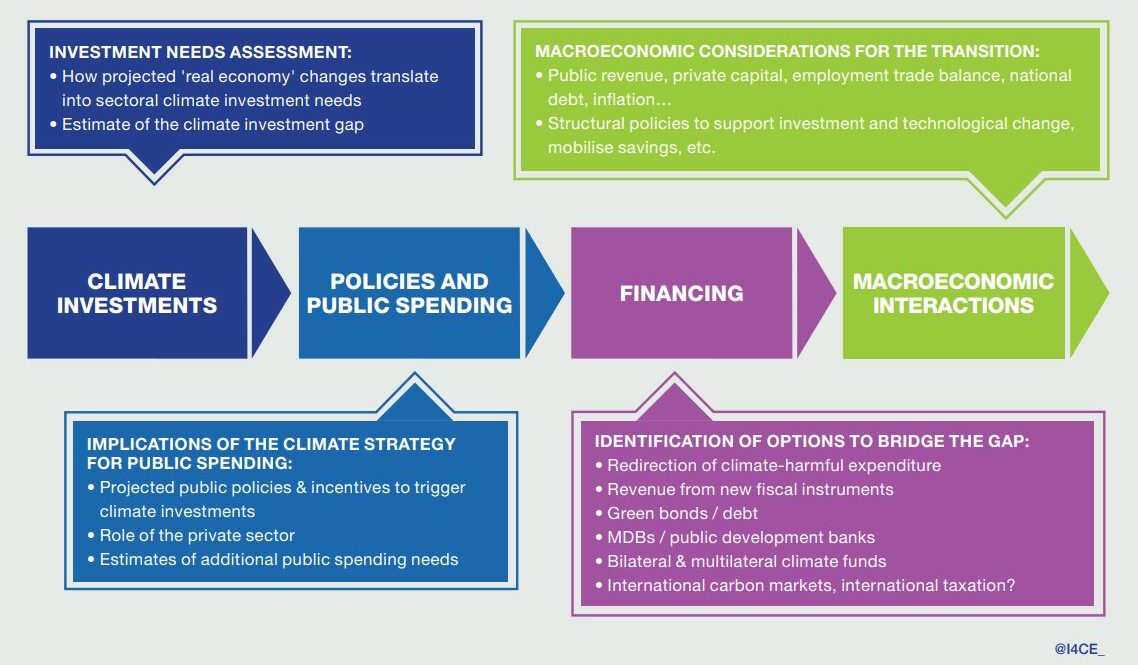Après Bonn et vers la COP 29 : la bataille du financement et le rôle des plans de financement pour la transition
Des négociations climatiques tendues viennent de s’achever à Bonn avec des progrès limités sur le financement et les engagements climatiques révisés dans le cadre de l’Accord de Paris. Cela contraste avec les ambitions exprimées lors de la cérémonie d’ouverture de la soixantième session des organes subsidiaires (SB 60) de la convention-cadre des Nations unies sur les changements climatiques (CCNUCC). Simon Stiell – Secrétaire exécutif – a souligné la nécessité de « faire de sérieux progrès en matière de financement, le grand facilitateur de l’action climatique » et de viser des contributions déterminées au niveau national de troisième génération (CDN 3.0) plus audacieuses, plus larges et plus inclusives qui « peuvent servir de plans directeurs pour propulser les économies et les sociétés vers l’avant et favoriser une plus grande résilience ».
Malgré des attentes initiales élevées, deux étapes clés du processus de la CCNUCC pour cette année et l’année prochaine n’ont pas ou peu progressé. Les négociations sur la première étape, le nouvel objectif collectif quantifié (NCQG) sur le financement de la lutte contre le changement climatique, qui vise à mettre à jour l’engagement actuel des pays développés à mobiliser des fonds pour les pays en développement, se sont enlisées au moment d’aborder la question cruciale des chiffres. Cet objectif doit être défini d’ici la fin de l’année lors de la COP29. De même, lors des discussions sur le deuxième jalon lié aux CDN 3.0, à soumettre en 2025 sur la base des résultats du premier bilan mondial présenté lors de la COP 28, les pays ont manqué d’ambition.
La COP29 doit maintenant relever le défi pour trouver des solutions et tracer des voies pour aller de l’avant. Les plans de financement pour la transition climatique sont une pièce maîtresse du puzzle qui peuvent contribuer aux discussions interconnectées sur le NCQG et les NDC 3.0. Un plan de financement permet de traduire les objectifs climatiques en une feuille de route pour les investissements. Avec la stratégie d’un pays – une CDN ou une stratégie à long terme (SLT) – comme point de départ, ces outils aident à définir les besoins d’investissement à court et à moyen terme et à estimer le déficit d’investissement, avec une approche globale de l’économie. Sur la base de ces données, ils aident également à définir les politiques nécessaires pour déclencher ces investissements et à identifier les options de financement pour combler le déficit, tout en intégrant des considérations macroéconomiques. Les éléments clés de ces plans est illustrée ci-dessous.
Rapport uniquement disponible en anglais
What do we mean by financing plans?
Financing plans are tools governments can use to reconcile different priorities while fostering an efficient and effective use of public finance. They can contribute to ensure that all financial flows are directed towards national low-emission and climate-resilient pathways, in line with national climate and development objectives. Moreover, they can shed light on the way forward on the country platform approach proposed by several actors to shift from the project-by-project approach and beyond the Just Energy Transition Partnerships (JETPs) model, seeing by some as “long on promise but short on progress”.
A financing plan helps translate climate goals into an investment roadmap. With a country’s strategy – an NDC or a Long-Term Strategy (LTS) – as the starting point, these tools help define short- and medium-term investment needs and estimate the investment gap, with a whole-of-economy approach. With these inputs as a basis, they also help define policies needed to trigger those investments and identify funding options to fill the gap, while integrating macroeconomic considerations. Our view of the key components of these plans is illustrated below.
Financing plans: key building blocks

Source: I4CE 2024.
And although all countries can benefit from such plans, they are even more relevant for developing countries that are confronted with limited fiscal space to address climate and development priorities.
With a financing plan at hand, governments can give a clear signal to the private sector and international funders as to where public efforts should be supported and/or supplemented. And this is where the connection with the NCQG starts.
Financing plans and the NCQG: ensuring climate finance based on needs
There is a general agreement on the fact that the NCQG must be based on the needs and priorities of developing countries, and from a floor of USD 100 billion –previous commitment. In emerging and developing economies (excluding China), these needs have been estimated at around USD 2.4 trillion per year by 2030. Thus, no matter how ambitious the NCQG ends up being, it will not be enough to meet those growing needs, and an effective use of these vital resources is essential.
When guided by a financing plan aligned with a country’s climate targets, international climate finance can truly serve those needs and priorities and be used more effectively.
The NCQG process can hence benefit from and should support the development of financing plans. The integrated perspective they provide would bring clarity as to where financial support needs to go, help prioritise and ensure impact towards the achievement of climate goals. Yet many countries will need support to come up with these plans, as well as to implement them.
Financing plans and the NDCs 3.0: aiming for climate investment roadmaps
NDCs embody efforts to reduce emissions and adapt to the impacts of climate change that each country must undertake and communicate, as established in article 3 of the Paris Agreement. In line with this article, NDCs should be designed as comprehensive instruments including targets for mitigation, adaptation, finance, technology development and transfer, and capacity building; and complying with transparency guidelines. They are expected to show progress over time, which is why they are required to be updated every five years, while recognizing the need to support developing country Parties for effective implementation.
The new round of NDCs is the opportunity to finally arrive to the comprehensive instruments they were meant to be, integrating all means of implementation and particularly finance. For developing countries, the challenge would remain nationally focused. While for developed countries, considering their current and future commitment to provide and mobilise climate finance for developing countries, their NDCs should ideally include their commitments of financial support.
NDCs 3.0 should then also function as an investment plan that countries can use to guide their public finance management decisions, their policies and international commitments, and to access climate finance matching their needs.
Assessing countries’ progress on financing plans for the transition
With increasing recognition of the key role of finance as an enabler of climate action, countries around the world have taken steps forward to develop tools to finance the transition pathways set in their NDCs and LTSs. Yet not all countries are moving at the same speed on this issue. Some may need support to arrive to even the first step of defining climate investment needs, while others may be more advanced on the path and could provide valuable insight to others based on their experiences.
At I4CE, we have embarked on a journey to contribute with an assessment of countries’ progress towards the development and implementation of financing plans for the transition. Our plan is to track this progress for each of the building blocks that in our view should be addressed in such plans. The table below shows an example of some macro indicators we are exploring to come up with a benchmark of G20 + 6 countries towards COP 29 and beyond.
With this work, we aim to provide insight on the current state of things and way forward, and to contribute to the interconnected discussions on the NCQG and the NDCs 3.0, with key recommendations based on the lessons learned.
The first GST recognized the world is not on track to meet the objectives set in the Paris Agreement, and these milestones may be the last opportunity to revert the trajectory. A successful NCQG is equivalent to keeping a lifeline for many countries, while progressive, more ambitious, and comprehensive NDCs are the needed cure that can take us out of the emergency room. In their intersection, financing plans are needed to ensure effectiveness in the use of climate finance provided and mobilised, and in the implementation of country climate strategies.
This blogpost was written by Diana Cardenas Monar, Research Fellow at I4CE within the ‘Steering Tools for Financing the Transition’ team, with the important contribution of Gracia Rahi, Research Assistant, for the elaboration of the country assessment table. If the above arguments have sparked any ideas, we would really value your thoughts. We welcome all feedback and expressions of interest to support this ongoing work and others related to financing plans for the climate transition.
